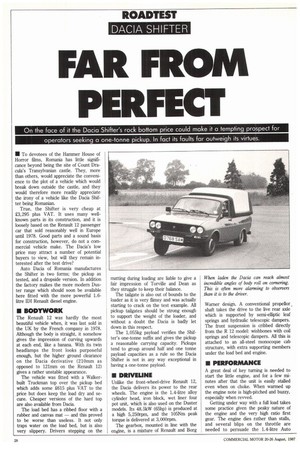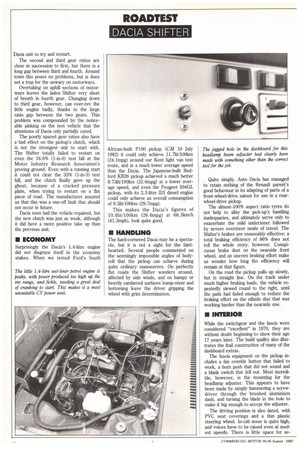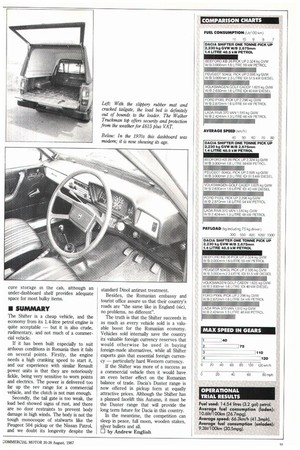FAR FROM
Page 30

Page 32

Page 33

If you've noticed an error in this article please click here to report it so we can fix it.
PERFECT On the face of it the Dacia Shifter's rock bottom price could make it a tempting prospect for o•erators seekin• a one-tonne pickup. In fact its faults far outweigh its virtues.
• To devotees of the Hammer House of Horror films, Romania has little significance beyond being the site of Count Dracula's Transylvanian castle. They, more than others, would appreciate the convenience to the plot of a vehicle which would break down outside the castle, and they would therefore more readily appreciate the irony of a vehicle like the Dada Slidter being Romanian.
True, the Shifter is very cheap at E3,295 plus VAT. It uses many wellknown parts in its construction, and it is loosely based on the Renault 12 passenger car that sold reasonably well in Europe until 1978. Good parts and a sound basis for construction, however, do not a commercial vehicle make. The Dada's low price may attract a number of potential buyers to view, but will they remain interested after the test drive?
Auto Dacia of Romania manufactures the Shifter in two forms; the pickup as tested, and a dropside version. In addition the factory makes the more modern Duster range which should soon be available here fitted with the more powerful 1.6litre IDI Renault diesel engine.
• BODYWORK
The Renault 12 was hardly the most beautiful vehicle when, it was last sold in the UK by the French company in 1978. Although the body is straight, it somehow gives the impression of curving upwards at each end, like a banana. With its twin headlamps the front looks purposeful enough, but the higher ground clearance on the Dacia derivative (210mm as opposed to 121rrun on the Renault 12) gives a rather unstable appearance.
The vehicle was fitted with a Walkerbuilt Truclanan top over the pickup bed which adds some £615 plus VAT to the price but does keep the load dry and secure. Cheaper versions of the hard top are also available from Dada.
The load bed has a ribbed floor with a rubber and canvas mat — and this proved to be worse than useless. It not only traps water on the load bed, but is also very slippery. Drivers stepping on the matting during loading are liable to give a fair impression of TorviIle and Dean as they struggle to keep their balance.
The tailgate is also out of bounds to the loader as it is very flimsy and was actually starting to crack on the test example. All pickup tailgates should be strong enough to support the weight of the loader, and without a doubt the Dada is badly let down in this respect_ The 1,055kg payload verifies the Shifter's one-torme suffix and gives the pickup a reasonable carrying capacity. Pickups tend to group around half and one tonne payload capacities as a rule so the Dada Shifter is not in any way exceptional in having a one-tonne payload.
• DRIVEUNE
Unit!lie the front-wheel-drive Renault 12, the Dada delivers its power to the rear wheels. The engine is the 1.4-litre alloy cylinder head, iron block, wet liner four pot unit, which is also used on the Duster models. Its 48.5kW (65hp) is produced at a high 5,250rpm, and the 105Nm peak torque is delivered at 3,000rpm.
The gearbox, mounted in line with the engine, is a mixture of Renault and Borg Warner design. A conventional propellor shaft takes the drive to the live rear axle which is supported by semi-elliptic leaf springs and hydraulic telescopic dampers. The front suspension is cribbed directly from the R 12 model: wishbones with coil springs and telescopic dampers. All this is attached to an all-steel monocoque cab structure, with extra supporting members under the load bed and engine.
PERFORMANCE
A great deal of key turning is needed to start the little engine, and for a few minutes after that the unit is easily stalled even when on choke. When warmed up the engine note is high-pitched and buzzy, especially when revved.
Getting under way with a full load takes some practice given the peaky nature of the engine and the very high ratio first gear. The engine dies rather than stalls, and several blips on the throttle are needed to persuade the 1.4-litre Auto Dacia unit to try and restart.
The second and third gear ratios are close in succession to first, but there is a long gap between third and fourth. Around town this poses no problems, but is does set a trap for the unwary on motorways.
Overtaking on uphill sections of motorways leaves the laden Shifter very short of breath in fourth gear. Changing down to third gear, however, can over-rev the little engine badly, thanks to the large ratio gap between the two gears. This problem was compounded by the noticeable pinking on the test vehicle that the attentions of Dacia only partially cured.
The poorly spaced gear ratios also have a bad effect on the pickup's clutch, which is not the strongest unit to start with. The Shifter totally failed to restart on even the 16.6% (1-in-6) test hill at the Motor Industry Research Association's proving ground. Even with a running start it could not clear the 33% (1-in-3) test hill, and the clutch finally gave up the ghost, because of a cracked pressure plate, when trying to restart on a flat piece of road. The manufacturer assured us that this was a one-off fault that should not occur in future.
Dacia soon had the vehicle repaired, but the new clutch was just as weak, although it did have a more positive take up than the previous unit.
• ECONOMY
Surprisingly the Dacia's 1.4-litre engine did not disgrace itself in the economy stakes. When we tested Ford's South
African-built P100 pickup (CM 10 July 1982) it could only achieve 11.71it/100km (24.1mpg) around our Kent light van test route, and at a much lower average speed than the Dacia. The Japanese-built Bedford KB26 pickup achieved a much better 8.731it/100km (31.6mpg) at a lower average speed, and even the Peugeot 504GL pickup, with its 2.3-litre IDI diesel engine could only achieve an overall consumption of 9.5lit/100Icm (29.7mpg).
This makes the Dacia's figures of 10.611t/100km (26.6mpg) at 66.3km/h (41.3mph), look quite good.
• HANDLING
The hard-cornered Dacia may be a spectacle, but it is not a sight for the fainthearted. Several people commented on the seemingly impossible angles of bodyroll that the pickup can achieve during quite ordinary manoeuvres. On perfectly flat roads the Shifter wanders around, affected by side winds, and on bumpy or heavily cambered surfaces bump-steer and bottoming leave the driver gripping the wheel with grim determination. Quite simply, Auto Dacia has managed to retain nothing of the Renault parent's good behaviour in its adapting of parts of a front-wheel-drive saloon for use in a rearwheel-drive pickup.
The almost-100% aspect ratio tyres do not help to allay the pick-up's handling inadequacies, and ultimately serve only to exacerbate the mild imdersteer followed by severe oversteer mode of travel. The Shifter's brakes are reasonably effective: a total braking efficiency of 86% does not tell the whole story, however. Conspicuous brake dust on the nearside front wheel, and an uneven braking effort make us wonder how long the efficiency will remain at that figure.
On the road the pickup pulls up slowly, but in straight line. On the track under much higher braking loads, the vehicle repeatedly slewed round to the right, until the pads had faded enough to reduce the braking effort on the offside disc that was working harder than the nearside one.
• INTERIOR
While the switchgear and the fascia were considered "excellent" in 1970, they are without doubt beginning to show their age 17 years later. The build quality also illustrates the frail construction of many of the dashboard extras.
The fascia equipment on the pickup includes a fan overide button that failed to work, a horn push that did not sound and a blank switch that fell out. Most incredible, however, is the mounting for the headlamp adjuster. This appears to have been made by simply hammering a screwdriver through the brushed aluminium dash, and turning the blade in the hole to make it big enough to accept the adjuster.
The driving position is also dated, with PVC seat coverings and a thin plastic steering wheel. In-cab noise is quite high, and voices have to be raised even at modest speeds. There is little space for se
cure storage in the cab, although an under-dashboard shelf provides adequate space for most bulky items.
• SUMMARY
The Shifter is a cheap vehicle, and the economy from its 1.4-litre petrol engine is quite acceptable — but it is also dude, rudimentary, and not much of a commercial vehicle.
If it has been built especially to suit arduous conditions in Romania then it fails on several points. Firstly, the engine needs a high cranking speed to start it, and our experience with similar Renault power units is that they are notoriously fickle, being very sensitive to worn points and electrics. The power is delivered too far up the rev range for a commercial vehicle, and the clutch is not man enough.
Secondly, the tail gate is too weak, the load bed showed signs of rust, and there are no door restraints to prevent body damage in high winds. The body is not the tough monocoque of stalwarts like the Peugeot 504 pickup or the Nissan Patrol, and we doubt its longevity despite the standard Dinol antirust treatment.
Besides, the Romanian embassy and tourist office assure us that their country's roads are "the same like in England (sic), no problems, no different".
The truth is that the Shifter succeeds in as much as every vehicle sold is a valuable boost for the Romanian economy. Vehicles sold internally save the country its valuable foreign currency reserves that would otherwise be used in buying foreign-made alternatives, while all Shifter exports gain that essential foreign currency — particularly hard Western currency.
If the Shifter was more of a success as a commercial vehicle then it would have an even better effect on the Romanian balance of trade. Dada's Duster range is now offered in pickup form at equally attractive prices. Although the Shifter has a planned facelift this Autumn, it must be the Duster range that will provide the long term future for Dada in this country.
In the meantime, the competition can sleep in peace, full moon, wooden stakes, silver bullets and all.
0 by Andrew English




















































































